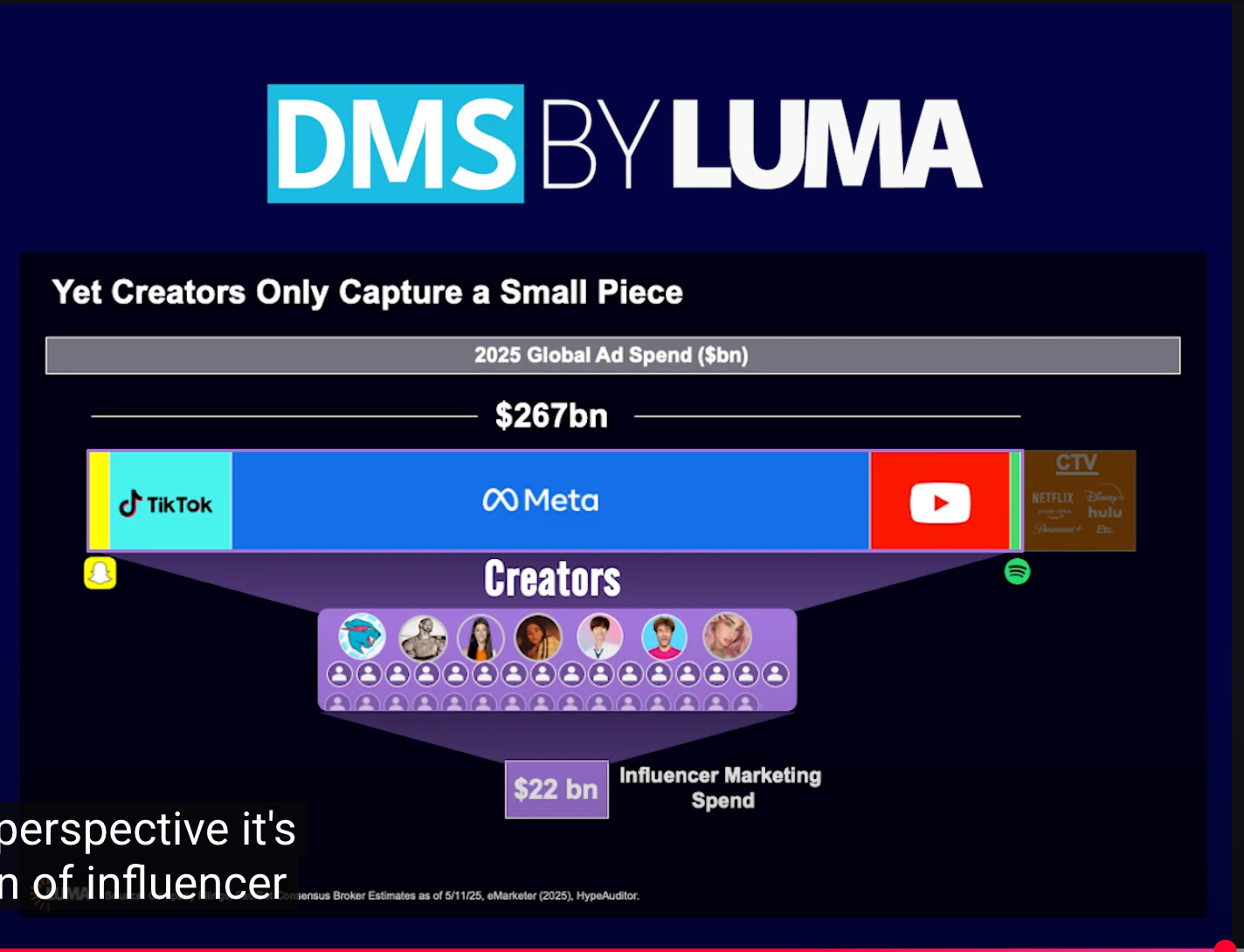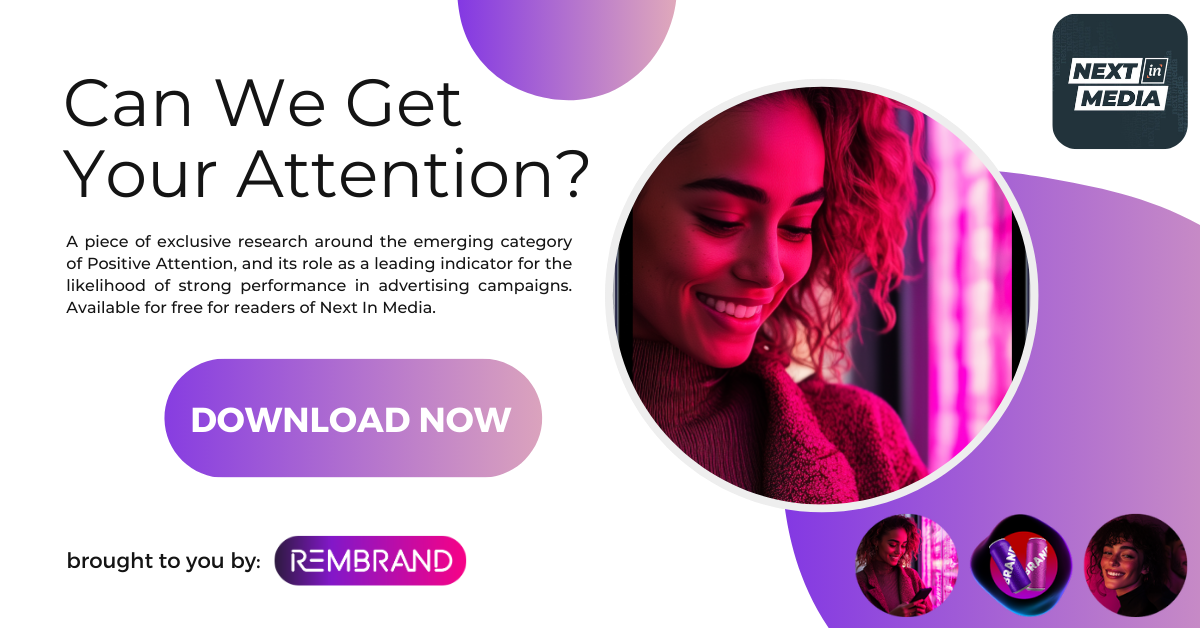Brands Are Under-Spending on Creators. Can Ad Tech (Finally) Help?
Big YouTubers may need to pressure Big Tech
The Creator Economy is booming.
YouTube is killing it on the ad front. So are Meta, Pinterest and even TikTok.
So brands are doing plenty to recognize the creator media revolution, right?
Not even close, according to Conor McKenna, partner at Luma Partners, the investment bank to the ad tech stars.
At Luma’s DMS event last week, McKenna and his colleague Terry Kawaja presented their annual state of digital report, during which they talked about tariffs, M&A action, and naturally, lots of AI.
They also presented this slide (which had to make the legacy media companies presenting upfronts at the same time last week shiver a bit):
Yet, like the famed Mary Meeker slides of old, ad spending is way behind time spent, per Luma.
Ok, but haven’t we talked about this before?
Creator ‘integrations’ are - by nature- not easy to execute, and thus tough to scale
Their impact is also hard to measure, given that they’re all about intangibles like ‘influence’ and ‘authenticity.’
There have been various attempts to automate such deals, which seem to have gone nowhere.
Ad tech doesn’t really have a place here. Plus, the big walled gardens don’t want them around anyhow.
Well, according to McKenna and Luma, several key factors have changed, and a whole new opportunity for ad tech innovation may be on the horizon. So I had him on my podcast this week to elaborate.
What’s changed?
Most big creators are on multiple platforms, not just YouTube, for instance
The biggest creators have a lot more clout, and may be invested in pushing for this kind of tech.
Giant brands like Unilever are saying they’d like to do a whole lot more with creators
Google is getting pressure from regulators to open up
AI could make all of this more feasible in ways that existing ad tech could not
What do advertisers and publishers have in common? Kochava. Our Growth Stack is the only measurement platform built from the ground up to serve both the demand and supply sides of the digital advertising industry—without compromise. Whether you're driving installs, increasing retention, proving ROI or monetizing traffic, Kochava connects the dots—across every device, platform, and partner. Trusted by top global brands, Kochava is the invisible engine behind outcomes-based growth.
Start measuring what matters with Kochava. Contact us for a demo or to learn more!
To date, creators have pulled ad budgets mostly from two buckets, McKenna said. “The creators bin, which is kind of like really bottom-level affiliate, or the top, sponsored content. The sort of big underlying thesis here is that they can be part of the broader paid media ecosystem overall.”
The new market conditions, “create opportunities for third-party tech to sort of sit on top of [the creator space], whether that's supporting creators or supporting the marketers and advertisers who are trying to get in front of audiences via these creators,” he said. “Yes, they can do it by buying ad slots on YouTube or Meta, but if there's ways to do even more connecting directly to creators, which is really the powerful place to be…historically that's been very tough to scale.”
Ok, but how would this new wave of creator ad tech work? Are we talking about putting brand integration opportunities on exchanges? Automating contracts? Virtual product placement?
After all, at DMS last week, Sean Downy, President of Americas & Global Partners at Google, in talking up the power of creators, cited Dove’s work with YouTuber Michelle Khare, which included an elaborate integration centered on the creator’s pursuit of a black belt.
Could a newfangled creator-DSP really help Dove pull off these kinds of deals?
Probably not. But, think about all the new generative AI tools that creators are rapidly adopting to produce or enhance their content. Why couldn’t these be channeled toward making better, faster, more scaled ad efforts, argued Natalie Silverstein, Chief Innovation Officer at Collectively, which specializes in the creator/marketing intersection.
“It’s not crazy [that ad tech could help here],” she said. “With AI and different tools , you’re seeing creators come up with faster, simpler assets. The more you could use those to take out the complexity, or the barrier to entry [for advertising], there’s a real opportunity.”
Silverstein noted that so much of her team’s work can end up being focused on licensing and business affairs complexity, and trying to map out production plans and various video cutdowns, which all tends to be laborious.
So, the ability to execute at higher speed and volume would be welcome. “It also has to work,” she said. “Is it good and at a scale, that’s always the tension.”
I wonder if brands and creators, both of whom like an element of control, would be willing to embrace any tradeoffs that might arise from AI-driven ad integrations. I also wonder if the ad tech and the social media world are just oil and water.
But McKenna believes some of this ad tech push may come from some of the bigger creators, as they mature into building real media businesses, and want easier ways to both monetize, and prove their value to big brands.
Today, “they don't have the data,” he said. “The data sits with the platforms. I think with AI, there's going to be more and more opportunities to measure things in unique ways…Then you can think of some of that upper, upper funnel creator dollars as paid media.”
By the way, over the past few weeks, in addition to my typical ‘long interview’ podcasts, I have been putting out bonus episodes with Emily Riley, a leading ad industry consultant and former analyst.
I’ve known Emily for a long time, and she understands this space as well as anybody. So we’re trying to see if there is room and interest in a weekly podcast that is more analysis/talk radio than simply a straight up interview.
Let us know what you think. And more importantly, reach out if you’d be interested in sponsoring this sort of thing…










Good points, lots of room now to help introduce scale and connect them with advertisers.